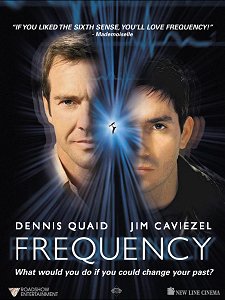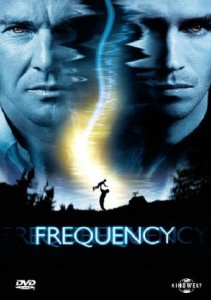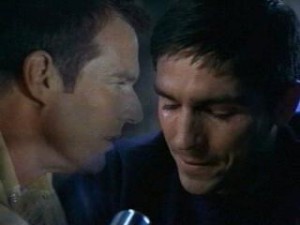This is one of my most “personal” posts. I first presented it in 2014.
 That line comes from my second-favorite movie of all time, Frequency. Released in 2000, this fantasy/baseball/serial killer/father & son relationship flick, starring Dennis Quaid and Jim Caviezel, has just about everything I could want in a story. But for my wife Jacqueline and me, it has given us even more.
That line comes from my second-favorite movie of all time, Frequency. Released in 2000, this fantasy/baseball/serial killer/father & son relationship flick, starring Dennis Quaid and Jim Caviezel, has just about everything I could want in a story. But for my wife Jacqueline and me, it has given us even more.
Frequency is our must-see New Year’s Eve movie because of the aforementioned line—slightly paraphrased. We’ve both been through our share of health issues, some life-threatening, so on that night—and many other times during the year—we look at each other and say, “We’re still here, Chief.” It’s perfect.
I present this brief plot synopsis with no spoiler alert, as I have no intention of revealing the ending, or even the latter part of the story, in case you’ve never seen Frequency. Sometimes I’m not even sure I totally GET the ending, as is the way with time-travel stories. What little left brain I possess will kick in with a number of “why” and “how” questions. Ultimately though, I just enjoy the story.
It’s 1969, the day before the New York Mets will play in their first World Series, and Queens firefighter Frank Sullivan (Quaid) comes home after a typical day at work—rescuing someone while risking his own life in a dangerous fire. Frank adores his family: wife Julia and six-year-old son John, whom he calls Little Chief. It is a doubly magical time for New York, as the Aurora Borealis flickers overhead. Frank puts John to bed by singing “Take Me Out to the Ballgame” before turning to his other hobby—his ham radio.
 It is now 1999, thirty years later to the day, and again the Aurora Borealis has appeared over the city. John Sullivan (Caviezel), now thirty-six, a cop, and possibly an alcoholic, still lives in the same Queens house. He is depressed over his long-time girlfriend walking out on him and does not look forward to the next day—the thirty-year anniversary of his father’s death in a deadly fire. He and his mother, Julia, will get together to mark the day.
It is now 1999, thirty years later to the day, and again the Aurora Borealis has appeared over the city. John Sullivan (Caviezel), now thirty-six, a cop, and possibly an alcoholic, still lives in the same Queens house. He is depressed over his long-time girlfriend walking out on him and does not look forward to the next day—the thirty-year anniversary of his father’s death in a deadly fire. He and his mother, Julia, will get together to mark the day.
A neighbor kid has come across Frank’s ham radio, unused for three decades, in a closet. Later, the radio comes to life, and John, with nothing better to do, starts talking to someone over the airwaves—his father, in 1969. As realization dawns, they both go through bouts of vehement denial—especially when John tells his dad how the first game of the Series turned out. But just before the connection is broken, John warns Frank about the warehouse fire and urges him to use his instincts.
The next day John investigates a crime scene where a skeleton has been dug up: a victim of a three-decades-old spree called the Nightingale Murders, as the three victims were all nurses. No murders occurred after 1969, but now the case is reopened out of curiosity.
In 1969 the Mets win the game, as John predicted. Frank considers this as he heads to an abandoned warehouse fire. Doing as John suggested, he manages to save a teenaged girl from the inferno and escape with his life. At the same time John, in 1999, begins to have new memories of his dad being there for him as he grew older. His friends tell him that Frank died of cancer ten years earlier. John rushes home and sees a message from thirty years ago being burned into his desk: I’m still here, Chief. This is not the last time we see or hear these same words.
 But by saving his dad, John has created a new timeline. In this one, Julia—a nurse—has been dead for thirty years, and the Nightingale killer has murdered not three but ten nurses, including Julia. They don’t know why—but we do. Originally, Julia was called away from her hospital shift when Frank was killed, and a patient named Jack Shephard—the killer—died due to a medical error. But in the new timeline, ironically, Julia stays at work and saves him, and he goes on killing. We also find out that Shephard is still alive in 1999. (Are you following all of this? It’s not too hard, trust me.)
But by saving his dad, John has created a new timeline. In this one, Julia—a nurse—has been dead for thirty years, and the Nightingale killer has murdered not three but ten nurses, including Julia. They don’t know why—but we do. Originally, Julia was called away from her hospital shift when Frank was killed, and a patient named Jack Shephard—the killer—died due to a medical error. But in the new timeline, ironically, Julia stays at work and saves him, and he goes on killing. We also find out that Shephard is still alive in 1999. (Are you following all of this? It’s not too hard, trust me.)
The pacing of the story now becomes intense as John uses information from the case files of the murders to guide his father into saving not only Julia but also other victims. Frank manages to save one, but as he watches the second victim he is attacked by Shephard, who realizes that Frank is following him. Shephard, a rogue cop, steals Frank’s driver’s license, learns his address, kills the next victim and sets Frank up as the killer. Even worse: as Frank is being arrested by one of his closest friends—and John’s boss in 1999—the ham radio is knocked to the floor and damaged, breaking the connection between father and son…
This is where I stop. You may find bits of Frequency confusing, even implausible, and it probably is. But let your right brain kick in and have a ball. This gem of a movie—both critically acclaimed and a box-office success—is well worth the two hours of viewing time.
And most of all, remember those four words: I’M STILL HERE, CHIEF.
